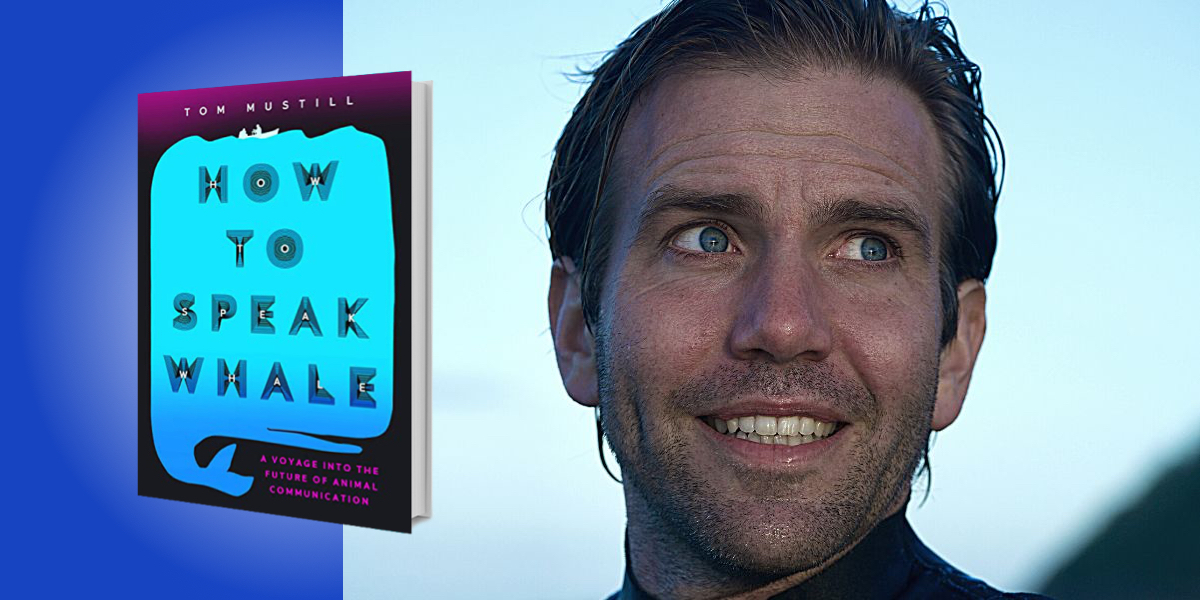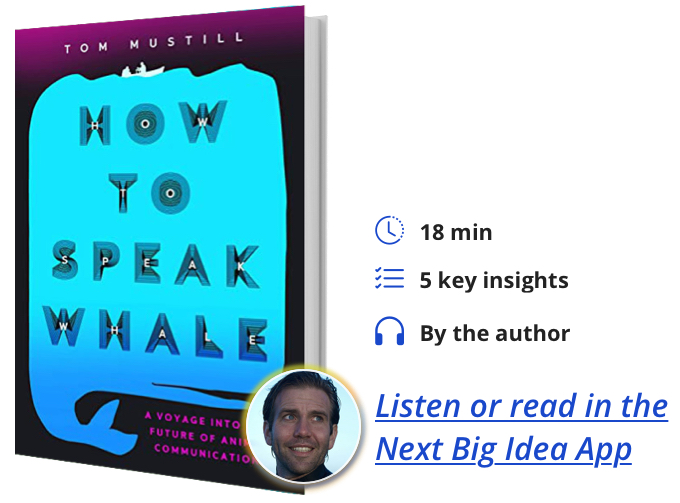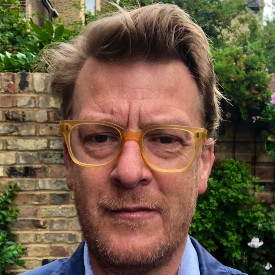Tom Mustill is a biologist turned filmmaker and writer, specializing in stories where people and nature meet. His film collaborations, many with Greta Thunberg and David Attenborough, have received numerous international awards, including two Webbys, a BAFTA, and an Emmy nomination.
Below, Tom shares 5 key insights from his new book, How To Speak Whale: A Voyage into the Future of Animal Communication. Listen to the audio version—read by Tom himself—in the Next Big Idea App.
1. What used to be anecdote is now data point.
In 2015, I was kayaking in Monterey Bay, California, when a 30-ton adult humpback whale breached out of the sea and down on to me and my friend Charlotte.
We had been on a whale-watching tour and were paddling back to shore when the whale erupted out of the ocean. It was shocking and incredible and beautiful, as if a living building grew out of the water. It crashed into the kayak and dragged us down. Somehow we escaped unharmed. For an animal the size of a truck to hurl itself out of the water, scientists have estimated it would release the energy equivalent of forty hand grenades. Other kayakers came to our aid and we paddled back to shore. Thrilled to be alive and processing the extraordinary experience we’d had, I didn’t realize we’d kayaked into a seismic change happening in biology.
As we’d paddled out that morning, Charlotte had asked me if I’d bring my two GoPros with me. No, I said, because everyone’s whale-watching videos looked the same. How wrong I was. And I was gutted because I didn’t think anyone would ever believe us. But others were filming on the water and our near death was captured on film and in close-up photographs by not one but three other people. The videos went viral and our lives were turned upside down.
Scientists who analyzed the recording told us that we had survived because the whale had seen us mid-flight and turned away. A citizen science platform called Happywhale used artificial intelligence to match the whale’s tail in new global databases, launched two weeks prior to our incident, and told us who the whale was, how old it was, who its mother was, and where it was born, and we have been able to follow its life ever since.
“Thrilled to be alive and processing the extraordinary experience we’d had, I didn’t realize we’d kayaked into a seismic change happening in biology.”
Another scientist played me the sounds of the humpbacks of Monterey Bay singing, recorded by a hydrophone recently placed on the seabed beneath where we’d almost died. He’d trained AIs to sort through years of recordings and identify different whale species by their calls. All of this was suddenly happening now. If the whale had leaped onto us a few years earlier, before cellphones with video cameras were everywhere, before fast internet was common, and before AIs had been trained to find patterns in whale lives, then my story would have ended as soon as it had begun—an exhilarating near-miss experience, unwitnessed and likely unbelieved. But instead, tens of millions of people watched a video of a whale that changed what they thought whales could do, and layers of meaning and connection could be followed from it to a much bigger story.
2. Machines are making biologists super-human, allowing us to record the lives of other species as never before.
After my chance encounter, I became obsessed. I spent the next four years attending conferences and interviewing scientists, traveling to see them deploying new tools. I watched as researchers placed exquisite tiny recording devices onto the backs of whales that gave us their points of view as they hunted, played, and suckled their young. I watched fleets of drones track the complex social interactions of hunting humpbacks, measuring them from above. I visited forests where small boxes sat at regular intervals, constantly listening for the sounds of the rare birds that lived there. I met autonomous sea vehicles, robots that navigated and powered themselves across entire oceans, listening all the while for life in the waves.
When Darwin set out on the HMS Beagle, he was limited by his own body. He could only perceive what his senses could perceive; he could only go where his body could go; he could only record in words what he had witnessed. Now you can buy an AI bird feeder that identifies the individual birds that visit your garden and uploads its sightings to the cloud. Your phone can tell you which of 10,000 plant species you are looking at just by pointing at them. The animal internet is arriving.
The upshot of this new machine help is that biology is transforming from being mostly the study of bodies to the study of the previously un-capturable: behaviors, movements, interactions, and communications. Machines have transformed the ability of biologists to perceive and record the living world. What they have seen has transformed our understanding of the lives of other animals, and this in turn has undermined our assumptions about what makes us humans special.
3. We are learning that humans are not as special as we thought.
In the last decades, Orcas have been found to possess many characteristics that were once thought uniquely human. They seem to mourn their dead, plan ahead, and play. Other cetaceans have been discovered to recognize their own reflections in mirrors and learn communication systems we teach them to follow sequences of commands. They solve problems and make tools. They’ve been discovered to have signature whistles, analogous to names for themselves. Some seem to kill for pleasure, others seem to exhibit altruism; I saw humpback whales defending the body of a dead gray whale calf.
“Orcas have been found to possess many characteristics that were once thought uniquely human.”
They use their virtuoso voices to separate themselves into acoustic clans based on the complex different sounds they make and teach one another sophisticated behaviors which they pass down as cultures. In a hospital in New York City, I witnessed the MRI scanning of the brain of a young sperm whale; the scientists showed me its great size, folds, grey matter, and special neurons, all of which in human brains are associated with complex cognition. The more we discover about their lives, with machine help, the more we learn that they can do things we thought only we could do.
That leads us also to the last bastion of human specialness… language. And here, computer intelligence could help reveal animal intelligences and communications that we did not suspect were present.
4. A Google Translate for animals.
A great hurdle for animal communication studies has always been the innate problem of the human observer. We cannot be watching all the time; we cannot record and remember everything; we cannot perceive patterns in their communications apart from very basic ones that relate to our own. Where we have failed to find evidence of complex communication, or figure out what it means, we have assumed it isn’t there and blamed the animals for failing our tests. And so we have decided that other animals don’t have something like language. But this seems hasty, and in the light of our track record on other things we used to think only humans did, foolish. Machines are changing all of this.
Google translate can switch between English and Urdu and Swahili without a bilingual dictionary. It works because AIs have discovered hidden deep patterns and relationships within human language that we could not perceive before and use these to translate without a Rosetta stone. Could these pattern-finding tools find patterns in the communications of other species? A Google translate for animals?
Several teams are already trying. Right now, off the waters of the island of Dominica, the seas are being rigged with the most sophisticated animal listening system ever devised to capture the entire vocal lives of the resident sperm whales. It is called project CETI. Hydrophones will float at 100 meter intervals. Soft robotic fish will swim among the whales recording their lives. The sperm whales themselves will carry recorders.
The team aims to gather the largest animal behavior dataset of all time. This is Big Animal Data. They are designing this dataset specifically to feed into their pattern-hunting AIs and attempt to crack the codes. By listening to the lives of the whales, including young whales learning to speak, they plan to piece together the rules of sperm whale speak. Then they hope to have a two-way conversation—they want to make contact. They are aiming to do this in a matter of years. And whales are just the start.
5. The power of empathy.
When I was born in 1983, we were slaughtering whales in the hundreds of thousands. If we had continued, the seas would likely no longer ring across the world with the whales’ beautiful calls. It was in the midst of the carnage of commercial whaling over half a century ago that Dr. Roger Payne was given a recording of these sounds from the waters of the Bahamas. He called them “rivers of sound.” By careful analysis, he realized that not only were they made by whales, but that, in his words, “By God they were repeating themselves.” They were made up of repeated patterns similar to notes, phrases and themes, refrains and choruses even rhythms and rhymes.
“As a conservationist, I know from experience that people are mainly motivated to protect those they can empathize with.”
When he proved that whales were singing, it made the front cover of Science. When he released an album of the recordings it sent shockwaves through human culture. People reacted powerfully to these songs from the ocean, and they became a phenomenon—played on television, in concerts, and launched into space on the Voyager space probes. That whales were like us in how they used their voices triggered an explosion of empathy that propelled the campaign to cease their slaughter.
Largely thanks to this, whales today are largely safe from whaling, but face warming acidifying overfished, and polluted seas. They are run over by our boats, deafened by our sonar, and fatally tangled in our nets. Roger is one of the lead scientists of project CETI, one of the teams trying to translate whale communications. What all the teams have in common is the hope that by decoding whale-speak, and the communications of other species, we might trigger another great change of heart.
Our relationship with nature is in a bad state today. As a conservationist, I know from experience that people are mainly motivated to protect those they can empathize with. I am compelled by Roger’s logic. If we could understand what whales and other animals were communicating—if we could see vividly what they cared about, their joys and pains—wouldn’t it change us?
The ramifications are wider than conservation. We have long clung to our specialness; would we feel challenged by what we learned? How should we safeguard the power that this new knowledge would give us and not use it to manipulate and exploit? If you discovered what your cat really thought about you, would your relationship survive?
To listen to the audio version read by author Tom Mustill, download the Next Big Idea App today:
































